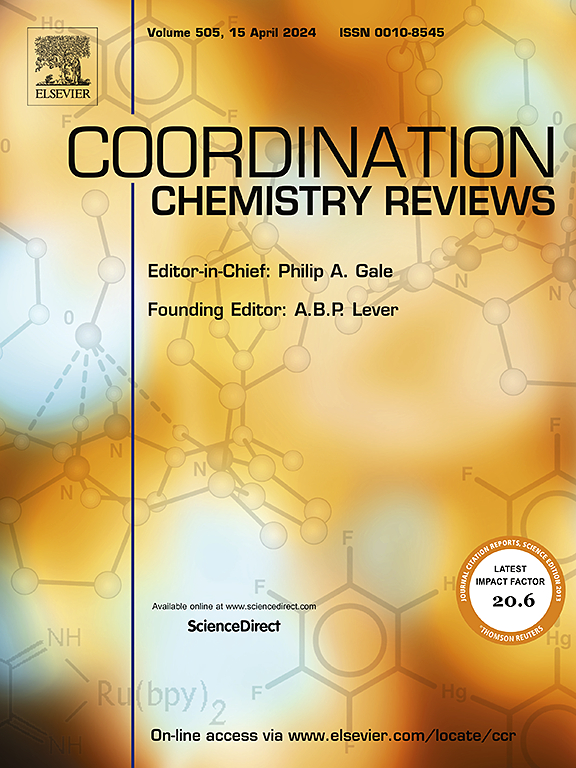基于金属有机配合物的酚类化合物的检测与降解
IF 20.3
1区 化学
Q1 CHEMISTRY, INORGANIC & NUCLEAR
引用次数: 0
摘要
酚类化合物是一类芳香物质,具有多种用途,包括药物、疾病标志物、农药、内分泌干扰物和工业化学原料。因此,准确测量和有效分解这些化合物具有重要的研究意义。金属-有机配合物(moc)由金属中心和有机配体组成,具有良好的稳定性、可调节性、易于制备和功能化等优点。这些配合物在分析和处理酚类化合物方面显示出独特的性能。本文对2019 - 2024年各类moc的合成过程、性能特征和活动调控策略进行了全面综述。本文综述的MOCs包括单金属MOCs、双金属MOCs、金属nanomaterials@MOCs、金属氧化物/sulfides@MOCs、MOCs@MOCs和分子印迹聚合物(MIPs)@MOCs、固定化MOCs、煅烧MOCs等。基于这些多功能moc,人们开发了一系列准确检测和有效降解酚类化合物的方法和技术。定量分析包括比色分析、比色传感器阵列(CSA)、荧光、电化学、表面增强拉曼散射(SERS)、电化学发光(ECL)、化学发光(CL)、高效液相色谱(HPLC)和多模式检测。高效降解技术包括催化剂活性氧源高级氧化工艺(CAO-AOP)、光催化降解和类酶催化降解。这些检测方法和降解技术的基本原理,优点,缺点和改进进行了彻底的检查。此外,从不同的角度讨论了现有研究的局限性和未来的发展趋势。本文综述的目的是促进多功能MOCs的创新,并改进检测和降解酚类化合物的方法。本文章由计算机程序翻译,如有差异,请以英文原文为准。

Detection and degradation of phenolic compounds based on metal-organic complexes
Phenolic compounds are a category of aromatic substances that serve various purposes, including pharmaceuticals, disease markers, pesticides, endocrine disruptors, and industrial chemical feedstocks. Consequently, accurately measuring and effectively breaking down these compounds holds significant research importance. Metal-organic complexes (MOCs), which consist of metal centers and organic ligands, offer several benefits, such as excellent stability, adjustability, and ease of preparation and functionalization. These complexes display unique properties in the analysis and treatment of phenolic compounds. This paper provides a comprehensive review of the synthesis processes, performance characteristics, and activity regulation strategies of various MOCs from 2019 to 2024. The MOCs included in this review are monometallic MOCs, bimetallic MOCs, metal nanomaterials@MOCs, metal oxides/sulfides@MOCs, MOCs@MOCs, and molecularly imprinted polymers (MIPs)@MOCs, immobilized MOCs, calcined MOCs, and others. Based on these multifunctional MOCs, a range of methods and technologies have been developed to accurately detect and effectively degrade phenolic compounds. The quantitative assays include colorimetric analysis, colorimetric sensor array (CSA), fluorescence, electrochemical, surface-enhanced Raman scattering (SERS), electrochemiluminescence (ECL), chemiluminescence (CL), high-performance liquid chromatography (HPLC), and multi-mode detection. The efficient degradation technologies include advanced oxidation processes of catalyst activation oxygen sources (CAO-AOP), photocatalytic degradation, and enzyme-like catalyzed degradation. The underlying principles, strengths, weaknesses, and improvements of these detection methods and degradation techniques are thoroughly examined. Furthermore, the limitations of existing research and future trends are discussed from various viewpoints. This review aims to foster the creation of innovative multifunctional MOCs and to enhance methods for detecting and degrading phenolic compounds.
求助全文
通过发布文献求助,成功后即可免费获取论文全文。
去求助
来源期刊

Coordination Chemistry Reviews
化学-无机化学与核化学
CiteScore
34.30
自引率
5.30%
发文量
457
审稿时长
54 days
期刊介绍:
Coordination Chemistry Reviews offers rapid publication of review articles on current and significant topics in coordination chemistry, encompassing organometallic, supramolecular, theoretical, and bioinorganic chemistry. It also covers catalysis, materials chemistry, and metal-organic frameworks from a coordination chemistry perspective. Reviews summarize recent developments or discuss specific techniques, welcoming contributions from both established and emerging researchers.
The journal releases special issues on timely subjects, including those featuring contributions from specific regions or conferences. Occasional full-length book articles are also featured. Additionally, special volumes cover annual reviews of main group chemistry, transition metal group chemistry, and organometallic chemistry. These comprehensive reviews are vital resources for those engaged in coordination chemistry, further establishing Coordination Chemistry Reviews as a hub for insightful surveys in inorganic and physical inorganic chemistry.
 求助内容:
求助内容: 应助结果提醒方式:
应助结果提醒方式:


